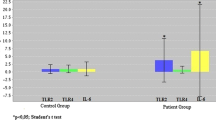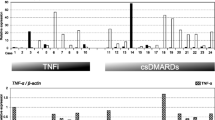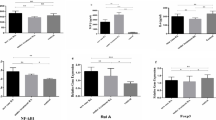Abstract
Lymphotoxin-Beta (LT-Beta) is implicated in lymphoid follicle development, production of pro-inflammatory cytokines, and can enhance the proliferation of fibroblasts and synoviocytes. The objective of this study was to investigate LT-Beta and LT-BetaReceptor (LT-BetaR) gene expression in RA patient synovium and blood samples compared with control individuals, and correlate with LT-Alpha and TNF-Alpha gene expression and disease parameters. RT-PCR was used to investigate the gene expression of LT-Beta, LT-BetaR, TNF-Alpha and LT-Alpha in the blood and synovium of RA patients and a control group of individuals. LT-Beta gene expression was significantly higher in RA patient synovium compared to control synovium (P = 0.005). There was a significant positive correlation between LT-Beta and LT-Alpha gene expression in both the synovium (P = 0.001) and blood (P = 0.002) of RA patients. LT-Beta gene expression was significantly higher in RA patient synovial samples that were inflamed to a moderately severe degree compared to those inflamed to a minimal degree (P = 0.02). Analysis of clinical variables revealed a significant positive correlation between LT-BetaR gene expression in RA patient synovium and Pain VAS Score (P = 0.01) and also HAQ Score (P = 0.01). Increased LT-Beta gene expression occurs in RA synovium and correlates with the degree of inflammation. LT-Beta may play a role in RA disease pathogenesis by contributing to a more intense inflammatory reaction in the synovium.




Similar content being viewed by others
References
Seldin MF, Amos CI, Ward R, Gregersen PK (1999) The genetics revolution and the assault on rheumatoid arthritis. Arthritis Rheum 42:1071–1079
Feldmann M, Brennan FM, Maini RN (1996) Role of cytokines in rheumatoid arthritis. Annu Rev Immunol 14:397–440
Weinblatt ME, Kremer JM, Bankhurst AD, Bulpitt KJ, Fleischmann RM, Fox RI et al (1999) A trial of Etanercept, a recombinant tumor necrosis factor receptor:Fc fusion protein, in patients with rheumatoid arthritis receiving methotrexate. NEJM 340:253–259
Browning JL, Ngam-ek A, Lawton P, DeMarinis J, Tizard R, Chow EP et al (1993) Lymphotoxin beta, a novel member of the TNF family that forms a heteromeric complex with lymphotoxin on the cell surface. Cell 26:847–856
Lu G, Janjic BM, Janjic J, Whiteside TL, Storkus WJ, Vujanovic NL (2002) Innate direct anticancer effector function of human immature dendritic cells. II. Role of TNF, Lymphotoxin-[alpha]1[beta]2, fas ligand, and TNF-related apoptosis-inducing ligand. J Immunol 168:1831–1839
Agyekum S, Church A, Sohail M, Krausz T, Van Noorden S, Polak J et al (2003) Expression of lymphotoxin-beta (LT-Beta) in chronic inflammatory conditions. J Pathol 199:115–21
Shlopov BV, Gumanovskaya ML, Hasty KA (2000) Autocrine regulation of collagenase 3 (Matrix Metallo Proteinase 13) during osteoarthritis. Arthritis Rheum 43:195–205
Mackay F, Majeau GR, Hochman PS, Browning JL. (1996) Lymphotoxin beta receptor triggering induces activation of the nuclear factor kappaB transcription factor in some cell types. J Biol Chem 271:24934–8
Mulcahy B, Waldron-Lynch F, McDermott MF, Adams C, Amos CI, Zhu DK, Ward RH, Clegg DO, Shanahan F, Molloy MG, O’Gara F (1996) Genetic variability in the tumor necrosis factor-lymphotoxin region influences susceptibility to rheumatoid arthritis. Am J Hum Genet 59(3):676–683
Newton JL, Harney SM, Wordsworth BP, Brown MA (2004) A review of the MHC genetics of rheumatoid arthritis. Genes Immun 5:151–157
Mandik-Nayak L, Wipke BT, Shih FF, Unanue ER, Allen PM (2002) Despite ubiquitous autoantigen expression arthrogenic autoantibody response initiates in the local lymph node. PNAS 99:14368–14373
Takemura S, Braun A, Crowson C, Kurtin PJ, Cofield RH, O`Fallon WM et al (2001) Lymphoid neogenesis in rheumatoid synovitis. J Immunol 167:1072–1080
Rennert PD, James D, Mackay F, Browning JL, Hochman PS (1998) Lymph node genesis is induced by signaling through the lymphotoxin beta receptor. Immunity 9:71–79
Ramey DR, Raynaud JP, Fries JF (1992) The health assessment questionnaire 1992: status and review. Arthritis Care Res 5:119–129
Anderson JJ, Chernoff MC (1993) Sensitivity to change of rheumatoid arthritis clinical trial outcome measures. J Rheumatol 20:535–537
Young CL, Adamson TC, Vaughan JH, Fox RI (1984) Immunohistologic characterization of synovial membrane lymphocytes in rheumatoid arthritis. Arthritis Rheum 27:32–39
Krenn V, Souto-Carneiro MM, Kim HJ, Berek C, Starostik P, Konig A et al (2000) Hitopathology and molecular pathology of synovial B-lymphocytes in rheumatoid arthritis. Histol Histopathol 15:791–798
Koizumi F, Matsuno H, Wakaki K, Ishii Y, Kurashige Y, Nakamura H (1999) Synovitis in rheumatoid arthritis: scoring of characteristic histopathological features. Pathol Int 49:298–304
Raff T, Van der Giet M, Endemann D, Wiederholt T, Paul M (1997) Design and testing of beta-actin primers for RT-PCR that do not co-amplify pseudogenes. Biotechniques 23:456–460
Braun A, Takemura S, Vallejo AN, Goronzy JJ, Weyand CM (2004) Lymphotoxin beta-mediated stimulation of synoviocytes in rheumatoid arthritis. Arthritis Rheum 50:2140–2150
Ansel KM, Ngo VN, Hyman PL, Luther SA, Forster R, Sedgwick JD et al (2000) A Chemokine-driven positive feedback loop organizes lymphoid follicles. Nature 406:309–314
Feldmann M, Andreakos E, Smith C, Bondeson J, Yoshimura S, Kiriakidis S et al (2002) Is NFkB a useful therapeutic target in rheumatoid arthritis. Ann Rheum Dis 61(Suppl 2):13–18
Kuprash DV, Osipovich OA, Pokholok DK, Alimzhanov MB, Biragyn A, Turetskaya RL et al (1996) Functional analysis of the lymphotoxin-B promoter. J Immunol 156:2465–2472
Voon DC, Subrata LS, Abraham LJ (2001) Regulation of lymphotoxin-beta by tumor necrosis factor, phorbol myristate acetate, and ionomycin in Jurkat T cells. J Interferon Cytokine Res 21:921–930
Campbell IK, Piccoli DS, Roberts MJ, Muirden KD, Hamilton JA (1990) Effects of tumor necrosis factor alpha and beta on resorption of human articular cartilage and production of plasminogen activator by human articular chondrocytes. Arthritis Rheum 33:542–552
Thomson BM, Mundy GR, Chambers TJ (1987) Tumour necrosis factor alpha and beta induce osteoblastic cells to stimulate osteoclast bone resorption. J Immunol 138:775–779
Kowanko IC, Bates EJ, Ferrante A (1988) Tumour necrosis factor-beta modulates human neutrophil-mediated cartilage damage. Scand J Immunol 28:591–598
Kuprash DV, Boitchenko VE, Yarovinsky FO, Rice NR, Nordheim A, Ruhlmann A et al (2002) Cyclosporin A blocks the expression of lymphotoxin alpha, but not lymphotoxin beta in human peripheral blood mononuclear cells. Blood 100:1721–1727
Ettinger R (2000) The role of tumour necrosis factor and lymphotoxin in lymphoid organ development. Curr Top Microbiol Immunol 251:203–210
Smith C, Andreakos E, Crawley JB, Brennan FM, Feldmann M, Foxwell B (2001) NK-kB-inducing kinase is dispensible for activation of NF-kB in inflammatory settings but essential for lymphotoxin B receptor activation of NFkB in primary human fibroblasts. J Immunol 167:5895–5903
Husson H, Lugli SM, Ghia P, Cardosso A, Roth A, Brohmi K et al (2000) Functional effects of TNF and lymphotoxin alpha1beta2 on FDC-like cells. Cell Immunol 203:134–143
Arend WP, Dayer J-M (1990) Cytokine and cytokine inhibitors or antagonists in rheumatoid arthritis. Arthritis Rheum 33:305–315
Drouet C, Shahhov AN, Jongeneel CV (1991) Enhancers and transcription factors controlling inducibility of the tumor necrosis factor-alpha promoter in primary macrophages. J Immunol 147:1694–1700
Kidd B (2004) What lessons can we learn from the study of pain pathways in rheumatic disease? J RCPE 34:66–67
Wu Q, Saloman B, Chen M, Wang Y, Hoffman LM, Bluestone JA et al (2001) Reversal of spontaneous autoimmune insulitis in nonobese diabetic mice by soluble lymphotoxin receptor. J Exp Med 193:1327–1332
Mackay F, Browning JL, Lawton P, Shah SA, Comiskey M, Bhan AK et al (1998) Both the lymphotoxin and tumour necrosis pathways are involved in experimental murine models of colitis. Gastroenterology 115:1464–1475
Tamada K, Tamura H, Flies D, Fu YX, Celis E, Pease LR et al (2002) Blockage of LIGHT / Ltbeta and CD 40 signalling induces allospecific T cell anergy, preventing graft-versus-host disease. J Clin Invest 109:549–557
Acknowledgments
This work was supported by ICARE (Irish Center for Arthritis Research and Education). We would like to thank Pat Higgins and Liam Burgess, Microbiology department for their technical assistance, Kathleen O` Sullivan for statistical support, colleagues in the department of Orthopaedic Surgery and Pathology, Cork Regional Hospital for acquisition and analysis of synovial biopsies, and participating patients for their consent in facilitating this study.
Author information
Authors and Affiliations
Corresponding author
Rights and permissions
About this article
Cite this article
O’Rourke, K.P., O’Donoghue, G., Adams, C. et al. High levels of Lymphotoxin-Beta (LT-Beta) gene expression in rheumatoid arthritis synovium: clinical and cytokine correlations. Rheumatol Int 28, 979–986 (2008). https://doi.org/10.1007/s00296-008-0574-z
Received:
Accepted:
Published:
Issue Date:
DOI: https://doi.org/10.1007/s00296-008-0574-z




